







•









•
®
OJoyce Bruno & Robert Weaver
Publisher and Editor
Robert Weaver
Columnists
Ronda Anson
Master Gardener
Abby Lapides
Sugar Creek Gardens
Steffie Littlefield
Edg-Clif Winery
Scott Woodbury
Cacalia Design & Wilding
Samantha Zale
Greenscape Gardens
Printing: Breese Publishing, Breese, IL
The Gateway Gardener® is published 9 times/year by Double Dig Communications, Inc. to promote enjoyable, successful gardening and livable landscapes in the St. Louis greater metropolitan area. The magazine is distributed free to the public at designated garden centers, nurseries, garden gift shops, lawn equipment rental, repair and sales establishments, and other locations supporting sound gardening, lawn and landscaping practices.
Please send letters-to-the-editor, questions, event announcements, editorial suggestions and contributions, photos, advertising inquiries and materials, and any other correspondence to:
The Gateway Gardener Magazine® PO Box 220853 St. Louis, MO 63122 Phone: (314) 968-3740
info@gatewaygardener.com www.gatewaygardener.com





ne of the perks I receive from publishing this magazine is, after reading each article two or three times in the course of editing and layout, some of the information actually sinks in, and my garden benefits from it. In this issue, for example, Scott Woodbury, contributor of our native gardening features, provided us with two articles. The second (page 14) is about one native plant, tall goldenrod (Solidago canadensis/altissima) that, while being an excellent pollinator plant and seed source for birds, is just too darned aggressive for most home gardens, and should be removed when (not if) it invites itself to your party. Last year I had a few such volunteers in my garden, but let them go because they so nicely complemented the purple/pink New England Asters they were rubbing shoulders with. This year, after reading Scott’s article, I took inventory and discovered the tall goldenrods had indeed—in one season—taken over a good part of the garden. So, I waited ‘til after a soaking rain, and exorcised the invading hordes! So extensive were the vacancies left behind, I made note of another feature in this month’s
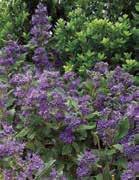

Tall goldenrod in the editor’s garden was beautiful with the fall asters, but it had to go.
issue, the Upcoming Events calendar (page 15), and in particular the many Native Plant sales coming in September! Feel free to apply these Gateway Gardener benefits to your garden. No charge!
I learn something in every issue from Abby Lapides’ articles as well. Like so many of her professional peers from our area independent garden centers, Abby stays on top of the latest plants being offered by growers each season, and shares many of her favorite findings with us while mixing in helpful tips for using those plants to improve our gardens. In this issue, on page 4, Abby picks a few new plants that can help us bridge
the gap between the summer bloomers and fall bloomers. We’re getting’ buggy with it in this issue. First, it’s time to think about bringing your houseplants in if they vacationed outside this summer. And that means the possibility of bringing insect pests in with them. Check out Samantha Zale’s primer on page 8 about common pests on houseplants and how to treat them. Then flip the page to see what Ronda Anson has to teach us about garden insects, in particular, why you shouldn’t reach for the insecticide at the first sign of them. Many, you’ll find out, are our friends!
Finally, I always include a few pepper plants in my garden. Why? Because it’s one of the few things the squirrels leave for me to harvest! Steffie Littlefield teaches us about peppers and how to grow them on page 6.
Since it’s back to school month, there’s your reading assignment for September. There’ll be a test next spring!
Good gardening!

by Abby Lapides

Just like marathoners at the end of a long race, sometimes our garden’s flower power begins to tucker out towards the end of the season. However, some of the best flowers bloom late! Burst through the flowering finish line with these beauties that flower from summer through fall. The queen of fall shade gardens must be the windflower, Anemone ‘Puff Pink’ is the newest and could be the prettiest of all. Very
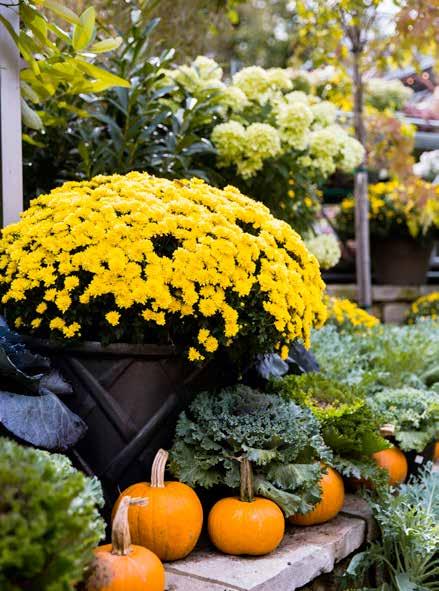

unusual, compact, pompon flowers cover this short plant with stems long enough for cutting. New flowers open a rich rose color and progress to an antique silver pink. The foliage grows to a 12″ mound, and when blooming, the flowers reach to 24″ tall. Striking displays are easy to create with ‘Blood Brothers’ red switch grass, Panicum. In summer, blue-green leaves are overtaken with dramatic wine-purple coloration. It matures to a strictly upright 3′ column of foliage. Red flowers turn into tan seedheads in late summer. It makes a spectacular specimen plant and is even more eye-catching when massed in the landscape. A selection of the US native perennial, red switch grass is easy to grow, not fussy about soil, and drought tolerant once established.

Black-eyed Susans, Rudbeckia, delight with flowers for months. Newer to the market, ‘Sunbeckia Laura’ stuns with multi-petaled flowers. Their huge, sunny petals surround bright green centers. These jumbo flowers can measure over 8″ across. Petals are double, meaning they have two rows, creating a showy full flower. Perfect for cutting gardens, the center of mixed containers, or planted alone

‘Sunbeckia
Laura’

for a striking display. Although they have proven to be hardy to zone 7, they have been known to come back in the St. Louis area.
Once it begins blooming, ‘Grand Bleu’ bluebeard, Caryopteris, doesn’t stop until a frost! In July, puffs of violet-blue flowers begin appearing in masses. These vibrant flowers are loved by pollinators. Expect to see a frenzy of activity around these nectarrich flowers. They are drought-tolerant, deer and bunny resistant.
‘Grand Bleu’ is perfect for dry, sunny spots, mixed in the perennial border, or planted in a pollinator garden. Growing about 2-3’ tall, ‘Grand Bleu’ may also be massed to create a dramatic low hedge or edging for a walkway or garden.
The fun never stops on ‘Summer Carnival’ rose mallow, Hibiscus Beginning in late summer, huge, over 7″ across, deep magenta flowers bloom in abundance. Vigorous variegated foliage of mint green, white, and pink emerges in late spring. As the foliage matures, the variegation becomes more striking, peaking at the same time flowers begin to appear. It will quickly grow over 4′ tall and wide. Though it looks like a tropical transplant, rose mallow is native to Missouri, thriving in our hot summers and easily wintering through our tough winters. Water-loving, it can handle
Abby Lapides is owner and a speaker at Sugar Creek Gardens Nursery. She has degrees from the University of Missouri, and is a member of the Landscape and Nursery Association of Greater St. Louis. You can reach her at (314) 965-3070.


When many plants begin to rest for the season, ‘Gilt Edge’ toad lily, Tricyrtis, is just beginning! In late summer and fall, when the shade garden desperately needs flowers, Gilt Edge produces ethereal orchid-like flowers of lilac and vibrant pink with purple speckles. You will want to experience the blossoms up close; the remarkable markings are Mother Nature’s best work. Gold-tipped foliage grows into a graceful mound of arching ladders – each leaf is born on stems alternately, creating the ascending appearance. Add a few of these lovely late-season jewels to keep your garden looking fresh through to the end of the season. Though many of these plants are drought tolerant, keep them well-watered when setting buds and blooming.



Vender s Tents to Shop and Explore








Food Trucks 9am to 3pm


Chicks on the Side, Lily & Kona Ice



Beer Garden


Red Door Liquor & Cigars



JukeBox Band






Live Music 11am to 3pm

Nursery & Garden Center Specials


Free for the Kids





Pony Rides 10am to 2pm
Dreams Come True Farms










Noon to 2pm
Spuds, Tater, and Petunia
Equine Asist Therapy





Kid s Corner Activities




10am to 3pm

















By Steffie Littlefield

Every vegetable gardener dreams of harvesting perfect peppers. They have so many flavors and so many uses, from sweet to hot, ornamental beauty to cooking ingredient. When planning your vegetable garden, you’ll probably want to include bell peppers, hot peppers, mild peppers, salsa peppers, stuffing peppers…. Wait don’t get too carried away. Let’s find the perfect peppers for your needs. Peppers are excellent in all sorts of dishes, raw and cooked. They can be frozen, dried or pickled, even used in jellies or relishes at season’s end and enjoyed in dishes throughout the winter.
At Edg-Clif Farms, we devote a whole 3’ x16’ bed to peppers. At one end I start with 2-3 jalapeños. These are a staple in so many Mexican recipes and even our favorite at the holidays, “Cranberry Salsa”. They do not take up much room and are prolific producers. Next I usually include some chili peppers, Serrano peppers and habanero peppers. There are many very hot and beautiful varieties of peppers. Be especially careful handling these peppers as the essence can burn your hands and eyes. Another use for hot peppers is to deter animal and insect pests from eating your other plants. Blend these hot peppers with detergents and oils to spray on your plants or simply plant them on the edge of beds or pots to keep deer and squirrels away.
In the middle of my bed is a grouping of milder horn

shaped peppers like Hungarian wax, Mariachi, Corno di toro, Anaheim or Poblano. These are really tasty for grilling, easy to freeze for soups and winter dishes or served fresh with creamy cheese dips. A big section of our garden is devoted to huge red and green bell peppers. Because we are in love with my sister’s
Steffie Littlefield is a St Louis area horticulturist and garden designer. She has degrees from St. Louis Community College at Meramec and Southeast Missouri State and is a member of Gateway Professional Horticultural Association, Missouri Botanical Garden Members Board and past president of the Horticulture Co-op of Metropolitan St. Louis. She is part-owner of Edg-Clif Winery, Potosi, MO. www.Edg-Clif.com.

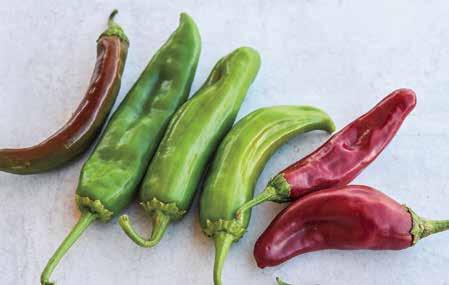
sassy pepper jelly, we use lots of red- and orangecolored peppers. The combination of sweet and hot peppers is delicious on cream cheese as a dip or as a marinade on meats and seafood!
Tricks we’ve learned in growing peppers:
Start seeds indoors early, like in February, because they are slow to germinate and grow.
Don’t plant in the garden until May. They hate cool and wet weather.
Raised beds for good drainage with lots of sun is essential.
Use small tomato cages for support. It keeps the large heavy peppers from pulling the plants over and even breaking them apart on windy days.
I usually rotate my beans in the bed one year and peppers the next for added nitrogen, but good organic fertilizer is helpful at planting.
Keep the water coming when rain is scarce.
Photos Courtesy Baker Creek Heirloom Seed Co./ rareseeds.com





By Samantha Zale

September is houseplant month! As we ease into fall, we need to start preparing for the process of overwintering our houseplants. This is the time to be gathering supplies, preparing landing spots and keeping our eyes peeled for pests. Most houseplants are going to need to come inside before the temperatures outside get below 50 degrees. There are a handful of plants that could handle temperatures as low as 40 degrees, however, 50 degrees is a good rule of thumb generally to keep in mind for most annuals & houseplants. As we get deeper into fall, we need to keep our eyes peeled on the forecasts so we are not caught off guard when temperatures dip below this threshold. We need to be mindful of where these plants are going once they come inside. Foremost, care needs to be taken if you have pets to make sure that you don’t have toxic plants within easy reach, including lilies, hibiscus, cyclamen, sansevieria, ZZ, oleander, euphorbia and monstera. Plants like hoya, parlor palms, calathea, ponytail palms, spider plants and staghorn ferns are more pet


friendly.
They are also more flexible regarding lighting needs, our next consideration. Even plants that summered in the shade outdoors will find themselves in reduced lighting situations inside. So, consider each plant’s needs when choosing an indoor winter home for them. Lighting in the winter can be tricky for plants that can normally handled full sun or bright-indirect light outdoors. Do you either have a south or a west facing window that can allow for as much sun as possible for plants like cacti and succulents? If you need to supplement, then finding a UV LED light will be a great addition in your toolbox.
The next step is to be ready to treat for pests. Remember an ounce of prevention is worth a pound of cure. Check leaves carefully for common pests like aphids, whitefly, mealybugs, etcl. Submerge the rootball in soapy water for several minutes to chase out ants, rolly pollies, and other soil dwellers.
Then, do a treatment for pests on a weekly basis. The best


Mealybugs look like patches of cotton, which are actually waxy coatings that protect the insect underneath. A cotton swab dipped in alcohol will effecctively treat small numbers. A larger infestation may require a systemic insecticide.
products to have on hand are systemic insecticide granules, neem oil, Mosquito Bits® and a diluted 70% isopropyl alcohol solution. The systemic gets worked into the soil where it works its way through the root system into the stems and leaves, so if a pest like mealy bugs, aphids or scale start munching on your plant they then succumb to this treatment. Many times, systemic is formulated to be applied to the soil every 8-12 weeks. Be sure to wear gloves because you will need to use your hands to get this adequately into the soil.
If you do find pests on your plant, then spray neem oil or a similar product directly onto the critters. This type of product works on contact by essentially suffocating the insect and can often be applied as needed. Mosquito Bits® are effective in controlling fungus gnat larvae in the soil. The isopropyl solution is good to have at the ready for spot treatments that can be applied either using a spray bottle, a paper towel or a Q-tip. This method tends to work well on mealybugs, white fly and scale (where their armored shells require a bit of manual labor to remove them).
Remember to check any chemical products used to make sure they are labeled for indoor use, safe for the plant you are treating, and application directions.






Some signs and symptoms of pests are yellowing leaves, spotting or mottled leaves, leaf curl or malformation, honeydew, and leaf drop. It is important to note that leaf drop, leaf curl and yellowing leaves can also be signs of a watering issue. In the winter it is a good rule of thumb to water most houseplants on a weekly basis. Some influencing factors to this are what kind of plant it is (is it a succulent or a calathea for example). For a succulent this may be too frequent and for a calathea not enough. Some plants, like calatheas, are going to need a bit of humidity especially since our homes tend to be very dry in the wintertime. Also temperature is a factor because if plants are stored in relatively cool place they may enter somewhat of a dormant period, alternatively, if they are in a more climate controlled area they’ll need regular care. While this is just the tip of the iceberg, this information can still be overwhelming so take this opportunity to swing by your local garden center to pick the brains of those folks. Happy Fall!
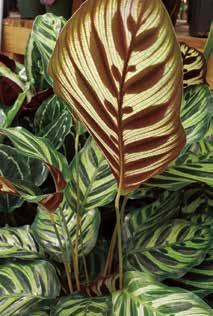
Calathea is a popular houseplant that requires frequent watering, while other houseplants like cacti and other succulent plants can go much longer in between watering.





by Ronda Anson

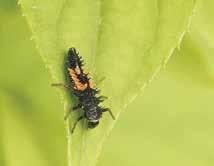

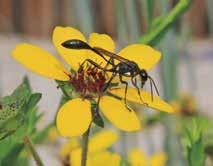
A few garden visitors you should consider friends, left to right: Green lacewing eggs dangling from tiny threads; hatch into larvae also called “aphid lions” (see photo on opposite page); ladybug larvae are even more voracious aphid eaters than their adult (3rd photo) forms; wasps are pollinators, but only accidentally, as they search for insects and spiders (both pest and beneficial) in the garden.
Photos by Robert Weaver
Which came first the pest or the predator? — That’s an easy one. The answer is the pest. In fact, that is why attempts to kill pests can actually lead to pest population explosions. When we spray for pests, we often don’t realize that we’re also killing the beneficials that, given time, would have controlled the pests.
Beneficials come in many shapes and sizes. Some are predators, some are parasites, others are diseases specific to a pest, and still others are Mother Nature’s recyclers that help break down dead plant or animal remains into useable organic matter that enriches
the soil and improves tilth.
Years ago, when I first became obsessed with gardening, I bought seeds for a perennial advertised to “attract” beneficials to my garden. I planted the seeds and the plants grew beyond my expectations. I was very excited because before then, I had never grown anything from seed, other than vegetables. One morning when I went out to see how my plants were doing, I was dismayed to find them covered in aphids. So, I got out the garden hose and washed them off. Each morning after that, I found more aphids and washed them off. Day after day, I washed those plants


The 22nd Northern Midwest ZNA Koi Show hosted by Gateway Koi and Pond Club
20, 21 & 22, 2024 Fri. 3-5pm, Sat. 9am-5pm and Sun. 10am-2pm







until finally I got fed up with it and yanked the plants, freeing my time for other activities.
It was a while before I realized why those plants were advertised to “attract” beneficials. It was the aphids. They are the prey that attract beneficial predators to your garden. Think of a mother ladybug flying around, looking for a place to lay her eggs. Why would she lay her eggs on a pristine leaf where there is no food for her babies to eat once they hatch from eggs? They would starve if she did that. Instead, she is looking for a plant with some nice, juicy aphids on it. The same would be true for the tiny parasitic flies and wasps that lay their eggs directly on the aphids or on other prey of their choice. Give them prey and they will come.
Trying to keep our landscapes free of what we call pests and what beneficials call dinner is crazy. It costs money, tires us out, and doesn’t do any good. Remember, the pests come back first and, unlike the beneficials, they are looking for a pristine plant with no predators in sight on which to lay their eggs or raise their babies, and it’s not usually a single baby; it’s a mass.
I gave up trying to get ahead of the pests over twenty years ago and have never regretted it since. My trees, shrubs, perennials and annuals are all thriving without extraordinary help from me. It has given me more time to yank weeds and help others with their gardening questions. I’ve had failures of course, but for the most part, I love the way my garden looks. I water when Mother Nature is slacking off on her job. I apply compost to nourish my plants every few years. I let the clover fertilize my lawn. I do apply extra fertilizer for some of the annuals. But I apply no
pesticide. I have only stepped in once, when a mob of tent caterpillars moved in on my newly planted sour gum and were rapidly defoliating it. So, yes, I sprayed the little devils. If it had been a mature, wellestablished tree, I would have just used a broom handle to open up the webs and let the birds take care of the problem. But I don’t think interfering once in twenty years is excessive or extraordinary and my tiny, little sour gum has grown into a beautiful, healthy tree that the beneficials now take care of for me.

Underneath this “pile of trash” is another man’s treasure. Lacewing larvae, welcome workers in the author’s garden, are voracious predators that sometimes stick the remains of their vanquished prey on their backs. Photo by Ronda Anson
Ronda Anson is certified as both an Illinois Master Gardener and St. Louis Master Gardener. She was a longtime Horticulture Answer Service and Plant Doctor volunteer at Missouri Botanical Garden where she developed an expertise in the world of insects. She coordinates the gardening answer service for MU Extension - St. Louis County, which you can reach at (314) 400-7657 or email: STLgardenhotline@gmail.com.


text and photos by Scott Woodbury





Not all who wander are lost. Some are searching for

From St. Louis to Kansas City, we live in the footprint of an ancient grassland called the tallgrass prairie. This rich and brilliant mosaic of colorful wildflowers, grasses, and sedges inspired some of our greatest educators and city planners, including Willhelm Miller, a horticulturist at the University of Illinois who promoted the prairie spirit in landscape gardening in 1900, and his contemporary, Jens Jensen, the landscape architect who made native landscaping fashionable in public parks throughout the Midwest. The architect Frank Lloyd Wright wove his “Prairie Style” into his designs for tapestries, stained glass windows, furniture, and low-profile houses that blended into the landscape. The spirit of the ancient tallgrass prairie continues to this day in so many ways. I’ll get back to this in a minute or two.
I recently visited a different grassland—one that exists at 6,000 feet elevation—in Switzerland. It also is a brilliant mosaic of colorful wildflowers, grasses, and sedges. So brilliant, in fact, that it has been featured in more than a few noteworthy films like the Sound of Music, Heidi, and the James Bond series, to name a few. I suppose the dramatic backdrop of mountains and ancient cities have something to do with the attraction.
But here’s the thing: those alpine meadows, full of wildflowers and grasses—the ones that set the scene for those movie classics—are showing up extensively in densely built Swiss city centers. They are being seeded, planted, and maintained by horticulture experts. Not surprising, because they are so colorful, though curiously, they don’t look like a garden. Instead, they look like Julie Andrew’ s hillside. In Zürich and many other cities that I visited, thousands of small patches of wildflowers, grasses, and sedges grow “wild,”
resembling mountain meadows.
In Swiss cities, wildflower patches are installed from seed (imagine the thriving seed industry!), and they are everywhere, even in the urban center. They exist around tree rings and along road edges right up to the urban curb (below) where they brush passing streetcars. They are grown in churchyards and parks to replace

mowed turf grass, and in the many spaces between buildings and other infrastructure. Many homes have significant portions of their landscapes sown with these wildflower mixes, especially on difficult-to-mow slopes.
It turns out that Swiss cities are uniformly and intentionally being developed as habitat mosaics, as well as showy wildflower and grass mosaics. Landscape and city planners, and their constituents, understand what Miller, Jensen, and Wright knew a century ago: that wherever you live, native landscapes have intrinsic beauty, historic value, and are essential for the survival of native plants and the insects, birds, reptiles, and mammals that depend on them, even potentially in highly urbanized areas.
The same can be true in Midwestern cities, many of which used to be enveloped in a mosaic of tallgrass prairie. By the way, our remnant prairies are every bit as beautiful and vibrant as Swiss wildflower meadows. Don’t believe me? Check out the incredible photos of tallgrass prairie at the Missouri Prairie Foundation website. Or walk through the prairie planting at the Donald Danforth Plant Science Center in St. Louis, which is a Grow Native! Garden of Excellence. Prairie patches are showing up more and more across the St. Louis and Kansas City regions.

Scott Woodbury was the horticulturist at Shaw Nature Reserve for 30 years and stepped down from that position in June 2022. He continues to work on contract for Shaw Nature Reserve to carry out native landscaping education and has launched his own business called Cacalia: Native Garden Design and Wilding. Find suppliers of native plants, seeds, and services at the Grow Native! Resource Guide: www. moprairie.org.
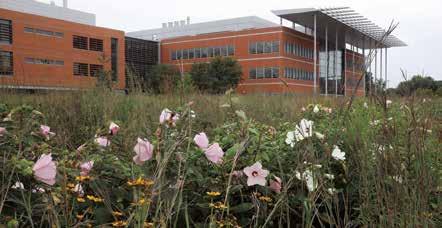
When wildflowers are utilized in such great force, especially in urban places, nature can be seen, heard, and enjoyed by its people like never before. I was there, in Switzerland. I saw it with my own eyes. And believe me when I say that the same thing is happening here in the Midwest, though we have work to do to catch up. We have work to do to educate and encourage each other. Let’ s reengage long-lost connections between people and nature wherever we live. Let’s be a force for nature, especially in places where nature is lost. Let Switzerland be an example to us as we move forward toward more colorful, wilder, more nature-centric communities. Happy wilding y’all.

9814 Pleasant Hill Rd Jefferson City MO 65109 www.mowildflowers.net mowldflrs@socket.net 573-496-3492
Meet us at one of these locations in St. Louis. Give us your order at least five days before a sale, and we will bring it to the location.
Kirkwood Farmer’s Market, 150 East Argonne Dr. Kirkwood MO 63122. Sept. 7 & 14; 8 a.m. to 4 p.m.
Shaw Nature Reserve - Glassberg Pavilions, 307 Pineton Loop Rd, Gray Summit MO 63039. Event: “2024 Fall Wildflower Market,” Sept 6, 3 p.m. to 7 p.m. www.shawnature.org.
Weldon Spring Site Interpretive Center, 7295 MO-94, St. Charles, MO 63304. Event: “Monarch Madness Pollinator Festival,” Sept 14, 10 a.m. to 3 p.m.
Missouri Pollinator Network (Facebook page)
Tower Grove Park - Roman Pavilion, 4378 Northwest Dr, St. Louis, MO 63110, Event: “Bring Conservation Home - Native Plant Sale,” Sunday, Sept. 22, 10 a.m. - 2 p.m. bit.ly/BCH-EXPO
Roeslein & Associates, Inc., 9200 Watson Road, St. Louis, MO 63126, Event: “Missouri Prairie Foundation Native Plant Sale,” Thursday, Sept. 26, 3:30 p.m. - 6:30 p.m. www.moprairie.org
Missouri Botanical Garden, 4344 Shaw Blvd. St. Louis, Mo 63110. Event: Best of Missouri Market, Oct 4, 12 p.m. - 8 p.m.; Oct 5, 9: a.m. - 5 p.m. (members 8-9 a.m.); Oct 6, 9 a.m. - 5 p.m. Admission charge varies, details: mobot.org




text and photo by Scott Woodbury
The last thing I want to do is poo-poo goldenrods, but there is one that destroys gardens, tall goldenrod (Solidago canadensis or S. altissima). It usually blows in from a nearby (or far-away) ditch or untended patch of ground. The seeds are light, fluffy and wind-borne on a breezy day, like so many other common garden weeds, like dandelion, mare’s tail, salsify, thistle, field aster, prickly lettuce, sow thistle, cottonwood, black willow, maples and sometimes cattail. These seeds can blow for miles, but when they finally land on bare ground, in an unsuspecting garden, they germinate, proliferate quickly and have the potential to absolutely wreak havoc.

The non-flowering foliage plants in front of the background plants are tall goldenrod. All sprouted as volunteers.
The unsuspecting gardener might think that tall goldenrod belongs in the garden because it can appear so suddenly, like it’s always been there. Or because it attracts so many pollinators when it’s golden yellow flowers appear in late summer and early fall. How can you say no to a plant that is covered in bees, wasps, beetles and monarch butterflies? Or perhaps because it’s a native plant, existing in extremely rare and ancient remnant tallgrass prairies, and open woodlands. What is the native gardener to do?
Many gardeners haven’t yet learned that it already exists in their neighborhood, even their own yard. It’s often hidden in plain sight, because when it’s not in bloom, it looks quite similar to other desirable native plants, like black-eyed Susan, yellow wingstem, eastern Blazingstar and other desirable goldenrods. Most unsuspecting gardeners or land managers never knew what hit them, because this plant can go from zero to flowering in a single season. In two seasons, it can colonize underground into a patch five feet wide. And by year three it’s game over, it has taken over entire sections of the garden. I see it all the time, especially in large gardens and rain gardens. Right now, it is snuffing out school gardens, college campus gardens, neighborhood gardens and homeowner gardens throughout the Midwest. I know of a multi-million dollar garden not far from my house that has been decimated, except for the trees and shrubs that can survive it. I know of a public garden in the city that came back from the brink, and thankfully is now thriving. I know of two college campus gardens in St. Louis that are suffering dearly and will be lost completely, if it’s not addressed this year. I have a neighbor up the street who saved her tiny garden by recognizing and removing a single plant early, before things got ugly.
If you are a gardener, you might want to take a closer look at your
plants. Tall goldenrod is tall at the end of the season (5-10 feet), but not so tall early in the season, so here’s what to look for when it’s not in bloom. It has tell-tale curved branch tips at the top of the plant, especially on a hot summer day. It looks like it’s wilting. It has alternate leaves and hairy stems. The leaves are three-nerved and narrow, tapered to a point up to 6 inches long. When you pull up a plant when the ground is moist, you can see the white rhizomes (suckering roots) that spread far and wide. The first course of action to get tall goldenrod under control, is to pull as many of these stems as possible to set them back and keep them from flowering. Some of the roots will remain and resprout from the ground, so you will need to follow up again (in spring) with more pulling or targeted herbicide spraying. If they are blooming or have just bloomed, cut the seed heads off and bag them immediately. Put them in the trash, because they will sprout in the compost bin.
There are plenty of other goldenrod species to choose from. Showy (S. speciosa), old field (S. nemoralis) and cliff (S. drummondii) goldenrods do well in full sun. They can spread from seed, but are easier to keep in check. Rigid goldenrod (S. rigida) is more difficult to control, because it gets big and clumps expand rapidly.
The shade-loving goldenrods include zigzag (S. flexicaulis), blue stem (S. caesea), rough-leaved (S. rugosa), Buckley’s (S. buckleyi) and elm-leaved (S. ulmifolia) goldenrods, though showy goldenrod tolerates part shade too. Elm-leaved goldenrod is the most aggressive of these.
The bottom line is that tall goldenrod has no place in new and developing sunny gardens. It simply will outgrow all of the other plants. The one exception is in shady open woodlands, where it can exist without taking over.
Lastly, goldenrods are keystone plant species, according to Doug Tallamy, author of Bringing Nature Home. That means that they are especially important for wildlife. They support/feed more insects than other plants. Those insects are crucial for feeding baby birds, mammals, and reptiles. Goldenrods are key to supporting entire food chains.
Scott provided bonus coverage to us this month, and we were happy to add it to his regular column appearing on the preceding pages. Please look there to find Scott’s full biography. --Ed.
Updates to this information are often posted on our online events calendar at GatewayGardener. com, so check there for the latest details.
Give us the details of your upcoming gardening, lawn or landscaping event and we’ll add it to our website and include it in our next issue. Deadline for printing in Winter issue (November-February) is October 1st.
How to reach us:
Mail: PO Box 220853, St. Louis, MO 63122
Email: info@gatewaygardener. com
Sept. 7th
9am—St. Louis County Parks and Recreation Children’s Garden Club: Plant A Pocket of Prairie. FREE. Greenscape Gardens & Gifts, 2832 Barrett Station Rd., Manchester, MO, 314-821-2440. Pre-registration is required on the St. Louis County website at https://tinyurl. com/5n6zx9ex or by calling 314615-4386.
Oct. 5th
9am—St. Louis County Parks and Recreation Children’s Garden Club: Painting Pumpkins. FREE. Sherwood’s Forest Nursery & Garden Center. 2651 Barrett Station Rd., Manchester, MO 63021. Preregistration is required on the St. Louis County website at https:// tinyurl.com/5n6zx9ex or by calling 314-615-4386.
Now through Sept. 26th
Brightside St. Louis Bulb Sale. Now is the time to order your Brightside bulbs. Visit www. Brightsidestl.org to view bulbs and submit an order or print out a
mail-in order. Or call (314) 7724646 before Sept. 26th. Orders will be available for pickup at the Forest Park Greenhouse on Oct. 11th from 11am-4pm, and on Oct. 12th from 9am-noon. Shipping orders will be ship the week of Oct. 7th
Sept. 6th
3-7pm—Fall Wildflower Market. Talk to native plant experts and shop from a wide selection of native plants suitable for all conditions. Cash and checks, some vendors take credit cards. Shaw Nature Reserve, Glassberg Pavilions 307 Pineton Loop, Gray Summit, MO. For more information visit shawnature.org.
Sept. 14th
9am-3pm—Fall Festival. Passiglia’s Landscape, Nursery & Garden Center, 1855 Hwy 109, Wildwood. Call 636-4314061 or visit passiglia.com.
Sept. 19th
6-7:30pm—Static Systems
Part of the Composting Class Series hosted by Seed St Louis, Table to Garden, and Willoughby Heritage Farm. Specific classes cover in-depth information and hands-on skills for compost bin systems, vermicomposting (worm composting), compost tumblers, Bokashi fermentation, and static compost systems. Wrap up the series with a microscopic examination of compost samples and free potluck dinner in October! All classes will be held at the new Compost Demonstration site at Willoughby Heritage Farm, 631 Willoughby Lane, Collinsville, IL 62234. Classes are $12/ea. Visit https://bit.ly/3GE34ws for more information and to register.
Sept. 20th-22nd
3-5pm Fri., 9am-5pm Sat., 10am-2pm Sun.—22nd Annual Northern Midwest ZNA Koi Show & Pond Expo. The event
will be held at Timberwinds Nursery in Ellisville, MO and is open to the public with free admission. There will be raffles, attendance prizes, koi judging and speakers on various topics of ponding and gardening Saturday, along with the judges’ talk and tour of the tanks on Sunday. Show koi will be removed from tanks for transport home on Sunday at noon. Koi, goldfish and pond & garden-related vendors will be open all three days. Show schedule is available on www.nmzna.net and www. gatewaykoiandpondclub. org. Come enjoy the beautiful living jewels of Japan! Fun for the whole family! Outdoor event-rain or shine! Gateway Koi and Pond Club hosts monthly educational meetings and fun events. Check us out on the website above and on Facebook! Or call 314-276-9461.
Sept. 21st
9am-noon—Native Plant Sale. Vendors include STLCC Horticulture Program, DIG Annuals & Perennials, Forrest Keeling, Ozark Soul Native Plants, Papillon Perennials and River City Natives. St. Louis Community College, 11333 Big Bend Blvd., West Parking Lot K, St. Louis, MO 63122.
Sept. 22nd
10am-2pm—Bring Conservation Home Native Plant Sale. Tower Grove Park, Roman Pavilion, 4378 Northwest Dr. 63110.
Sept. 26th
3:30-6:30pm—Native Plant Sale. Missouri Prairie Foundation. Roeslein & Associates, 9200 Watson Rd., St. Louis, MO.
Sept. 29th
1pm—Build Your Own Floral Pumpkin. Passiglia’s Landscape, Nursery & Garden Center, 1855 Hwy 109,
Wildwood. Call 636-431-4061 or visit passiglia.com.
Sept. 29th
5-7pm—Plein Air Art Festival and Competition. Reception and art sale benefits the beautification work of U. City in Bloom. University City Community Center, 975 Pennsylvania Ave. 63130. Tickets $20 in advance, $25 at the door. Visit UCityinBloom.org or call 314725-8243.
Oct. 4th-6th
Noon-8pm Friday, 9am-5pm Sat. and Sun. (8-9am Sat. members only)—Best of Missouri Market. Handmade artisan and craft items, and food, mostly from Missouri artists and producers, including native plants from Missouri Wildflower Nursery. Missouri Botanical Garden, 4344 Shaw, St. Louis.

